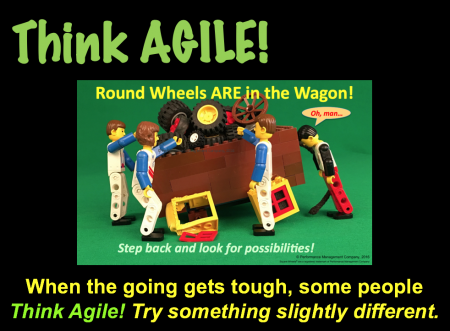My vision focuses on crafting a future environment for myself and my peers that balances work/life. And, not just in a cliché way of saying it, but truly balances the demands between being a good employee and being a good wife/husband/mother/father/citizen/dog owner/etc.…Everyone is asking for it, but it’s a scary seemingly slippery slope for me as a manager. So here is my opportunity to explore a vision of more remote, more collaborative, more agile work spaces, while also uncovering the challenges.
To start, my vision builds on DS playbook “plays”:
1. Understand what people need
2. Address the whole experience, from start to finish
3. Make it simple and intuitive
4. Build the service using agile and iterative practices
5. Structure budgets to support delivery
6. Assign one leader and hold that person accountable
7. Bring in experienced teams
8. Choose a modern technology stack
9. Deploy in a flexible hosting environment
10. Automate testing
11. Manage security and privacy through reusable processes
12. Use data to drive decisions
13. Default to open
Can the Agile playbook be applied to my non-IT vision? Why yes it can, and here are two reasons why:
1. Agile isn’t just for IT, it’s methodologies can be applied to any project/program/solution because incorporating Agile Digital Services techniques into solutions can lead to desired outcomes; and
2. Everything can use an IT DS solution (i.e. “there’s an app for that”)! We didn’t know some of the fastest most innovative companies, like Gucci, NBA, and Peloton (a stationary bike company), used DS until we completed DITAP Certification 1B; but now we know even the most unlikely candidates need DS. So, yes, of course my remote working solution needs a DS.
Using some of these Agile key plays, I will explore what a remote working structure will look for our contracting division.
Understanding What People Need:
Four simple words, but this play is layered like the 7-layer dip. What do people need? Who are the people? Who am I to understand it? I cannot answer these; but the first step in finding these answers is to identify the stakeholders: employees, managers, senior leaders, human resources, budget. All these stakeholders need to be engaged so that desired outcomes are identified, risks are mitigated, and constraints are captured. Essentially these are the people that will help me understand what is needed. For now, I’m going with the baseline that people need a flexible working environment, and managers need to be able to hold employees accountable.
Build the service using agile and iterative practices:
For my vision, the remote working environment doesn’t start until iterative practices have taken place. Building the trust, communicating effectively, setting and meeting expectations does not happen over-night, or in the first month. The process to get to a remote working environment will occur in iterative time periods, where we start with minimal (one day a week) telework. Once the teleworking relationship is established between a manager and an employee; a phased approach is implemented. The allowance of a remote environment is then reevaluated ever month. A stand-up meeting occurs every day between the manager and all team members. On any given week, the manager (or employee) may require that some or all employees work within the office. On any given week, the manager (or employee) may require work at a program office or contractor site. The manager and employee must be flexible and trust that they know where the best working location lies dependent on the work required that week. In other words, use your professional cognition to identify the appropriate working environment. This knowledge and trust will be built on the team cadence, technical/managerial/organizational skills. Again, it doesn’t come over night, it’s iterative and development is agile.
Assign one leader and hold that person accountable:
The leader in this case needs to be the direct supervisor (i.e. manager). That supervisor needs to be held accountable for production, milestones, fairness, ethical standards, turnover, training. How we measure these metrics needs to be established upfront, reevaluated each year, and measured with automated testing. The manager and other leadership need to quickly measure these key metrics, so decisions and adjustments are made before serious performance degradation and customer impacts are realized.
Bring in experienced teams:
An agile work environment is for experienced professionals. You must execute a high degree of technical, communication, professionalism, organization, self-regulation skills to achieve the high quality and timely outputs. That’s why an agile work environment doesn’t happen over-night, but here’s how it might look in the beginning:
• Start with small teams (one manager + 3/4 employees).
• Develop a team cadence with everyone in the office 100% for the first iteration
• Begin remote environments on consistent days (i.e. Taco/Telework Tuesdays).
• Build in reoccurring and frequent feedback/lessons learned; both from the manager and peer to peer.
Choose a modern technology stack:
Our formal office space has more spaces for collaboration and working openly together. While our work is sometimes individual, the knowledge, lessons, advise can be a shared experience. We will no longer need a farm of cubicles. Instead we will need shared work tables, with standing and sitting functions. Instead we will need breakout cubes and quite zones that offer privacy for phone calls and times where the employees really need individual space. In addition to conference and training rooms, we need small breakout meeting spaces that allow for video and phone conferencing. This means modern furniture, WIFI with high speed minimal disruption, modern desktop/laptop/tablet configurations, and secure wireless peripherals.
From the agile principles, key plays, my certification as well as my peer’s certification, the future of remote environments reevaluates how we use our workspace. Here are some examples of our future agile workspace space:
The revised space removes the traditional “everyone gets a cube”, and forces employees to plan, think, and execute based on sitting side by side or working individually. This shift in the office space accomplishes collaboration and team building, laying the foundation and preserving a healthy remote work environment. The open concept creates the space for feedback and conversations.
When we promote communication, build cadence, establish priorities, and measure against a schedule, we can begin thinking about completing tasks in the appropriate environment. The mix of individual and collaborate work, while holding employees accountable can lead to flexible, productive working conditions.











